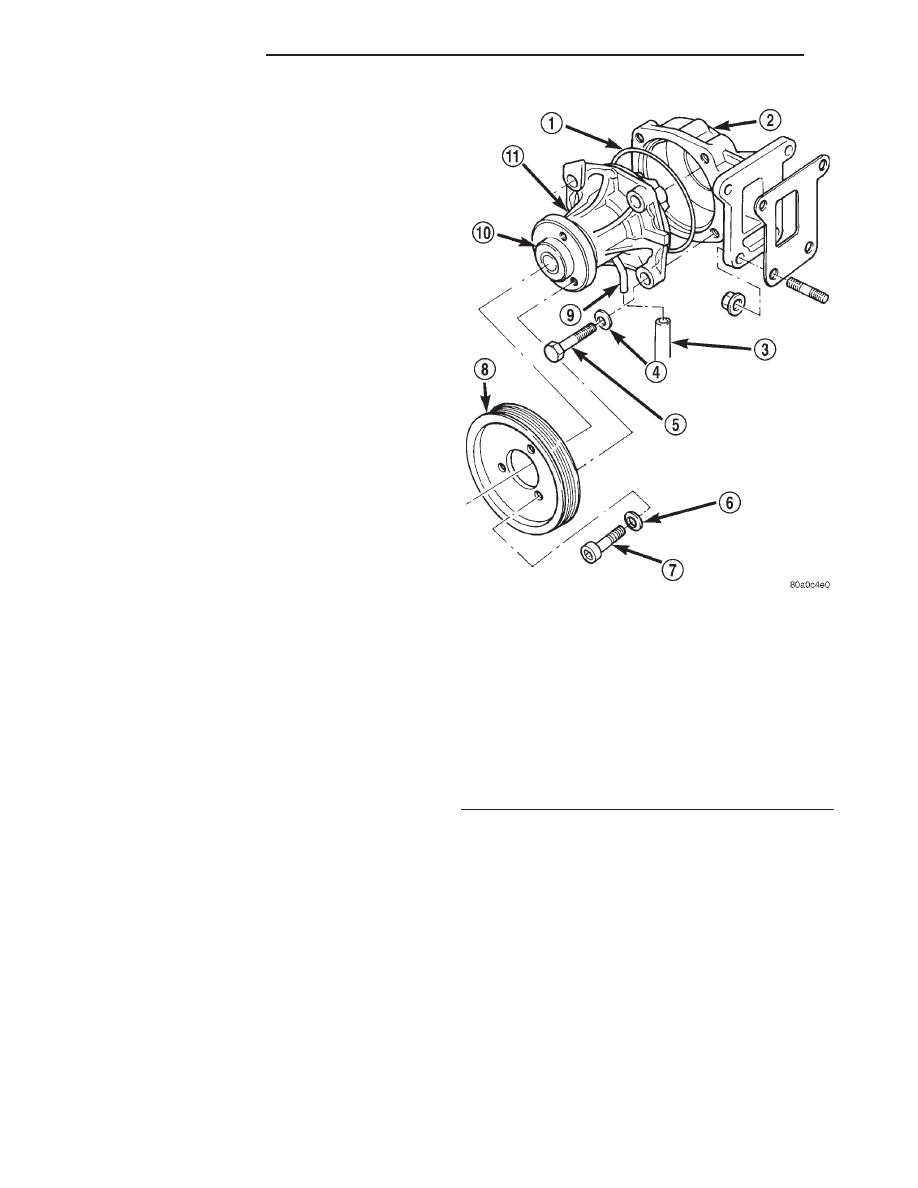Dodge Dakota (R1). Manual - part 269

WARNING: USE EXTREME CAUTION WHEN THE
ENGINE IS OPERATING. DO NOT STAND IN A
DIRECT LINE WITH THE FAN. DO NOT PUT YOUR
HANDS NEAR THE PULLEYS, BELTS OR FAN. DO
NOT WEAR LOOSE CLOTHING.
(5) Start the engine and operate at 2400 rpm.
Within ten minutes the air temperature (indicated on
the dial thermometer) should be up to 93° C (200° F).
Fan drive engagement should have started to occur
at between 82° to 91° C (180° to 195° F). Engage-
ment is distinguishable by a definite increase in fan
flow noise (roaring).
(6) When the air temperature reaches 93° C (200°
F), remove the plastic sheet. Fan drive disengage-
ment should have started to occur at between 57° to
79° C (135° to 175° F). A definite decrease of fan
flow noise (roaring) should be noticed. If not, replace
the defective viscous fan drive unit.
WATER PUMP
DESCRIPTION
A
centrifugal
water
pump
circulates
coolant
through the water jackets, passages, water manifold,
radiator core, pressurized coolant tank, cooling sys-
tem hoses and heater core. The pump is driven from
the engine crankshaft by a drive belt. The water
pump is bolted to the water pump adapter (Fig. 16).
The water pump adapter is bolted to the engine.
The water pump impeller is pressed onto the rear
of a shaft that rotates in bearings pressed into the
housing. The bottom of the housing is equipped with
a small vent tube (Fig. 16)to allow seepage to escape.
A drain hose is attached to this tube. The water
pump seals is lubricated by the antifreeze in the cool-
ant mixture. No additional lubrication is necessary.
A rubber o-ring (instead of a gasket) is used as a
seal between the water pump and the water pump
adapter (Fig. 16).
A quick test to determine if the pump is working is
to check if the heater warms properly. A defective
water pump will not be able to circulate heated cool-
ant through the heater hoses and the heater core.
REMOVAL
The water pump can be removed without discharg-
ing the air conditioning system (if equipped).
The water pump is serviced by replacing the pump
and its impeller only. The water pump adapter (Fig.
17) does not have to be removed. The pump impeller
is pressed on the rear of the pump shaft and bearing
assembly. The pump is serviced only as a complete
assembly with the impeller, housing, hub and bear-
ing.
A rubber o-ring seal (instead of a gasket) is used as
a seal between the water pump and the water pump
adapter.
WARNING:
DO
NOT
REMOVE
THE
CYLINDER
BLOCK DRAIN-PLUG, THE COOLANT TANK CAP,
THE RADIATOR FILL VENT VALVE, OR LOOSEN
THE RADIATOR DRAINCOCK WITH THE SYSTEM
HOT AND PRESSURIZED. SERIOUS BURNS FROM
THE COOLANT CAN OCCUR.
DO NOT WASTE reusable coolant. If the solution
is clean, drain coolant into a clean container for
reuse.
(1) Disconnect the negative battery cable.
Fig. 16 Water Pump— Typical
1 - O-RING SEAL
2 - WATER PUMP ADAPTER
3 - DRAIN HOSE
4 - WASHER
5 - PUMP MOUNTING BOLTS (4)
6 - WASHER
7 - WATER PUMP PULLEY BOLTS (3)
8 - WATER PUMP PULLEY
9 - VENT TUBE
10 - PUMP HUB
11 - WATER PUMP
7a - 22
2.5L VM DIESEL
R1
VISCOUS FAN DRIVE (Continued)